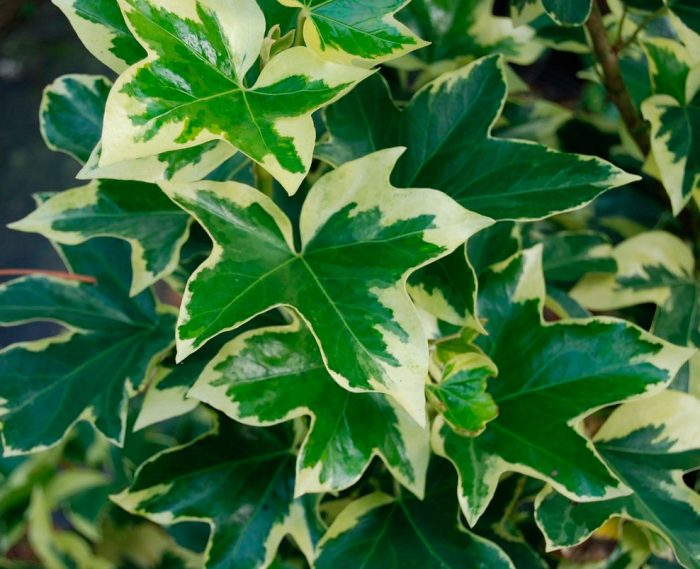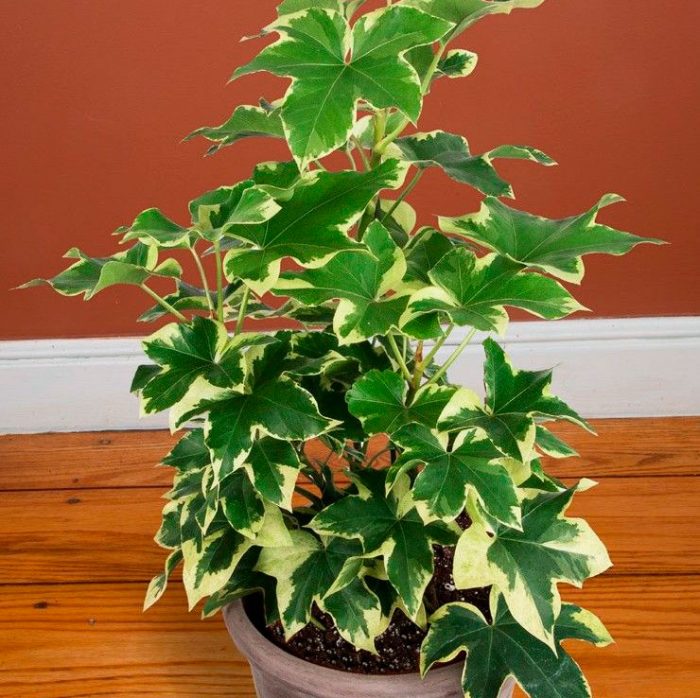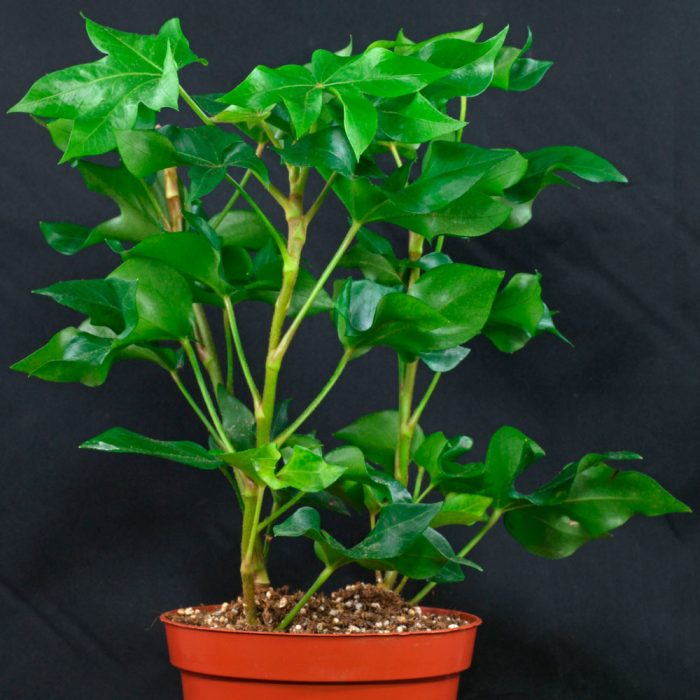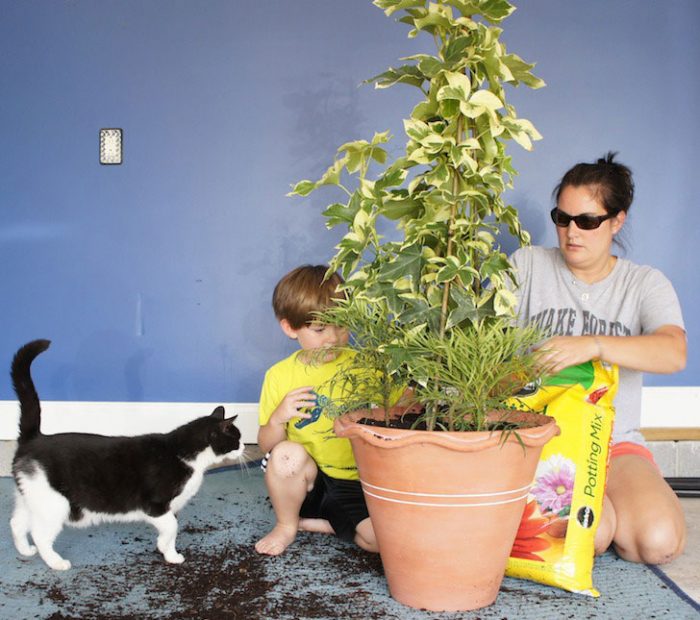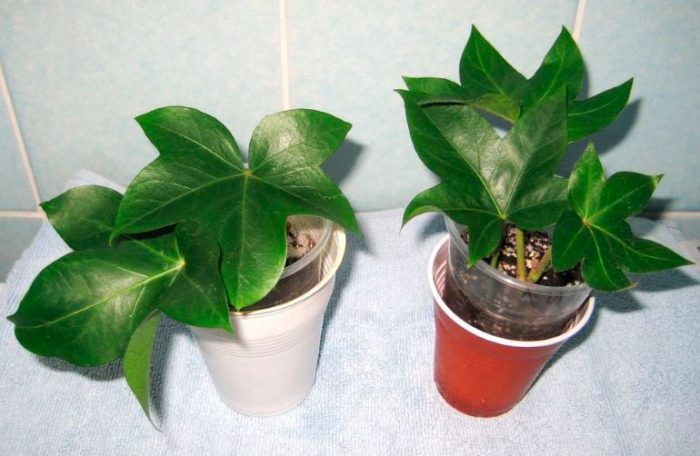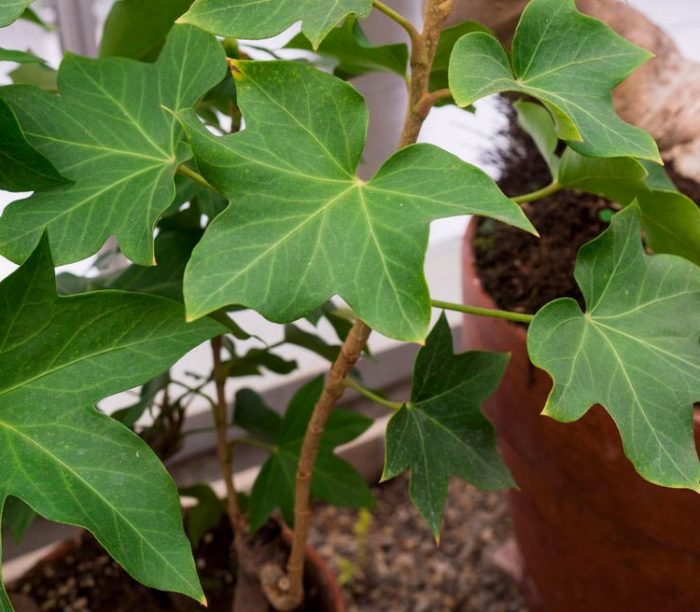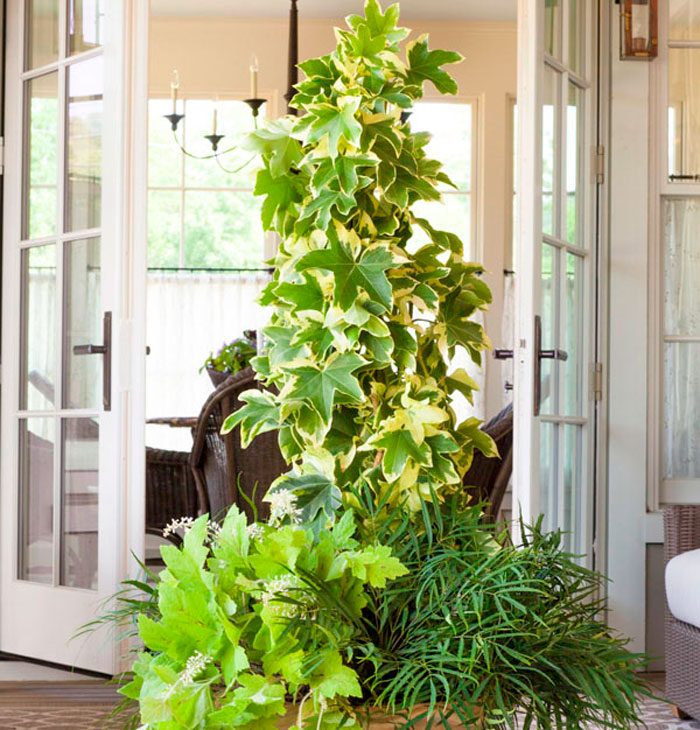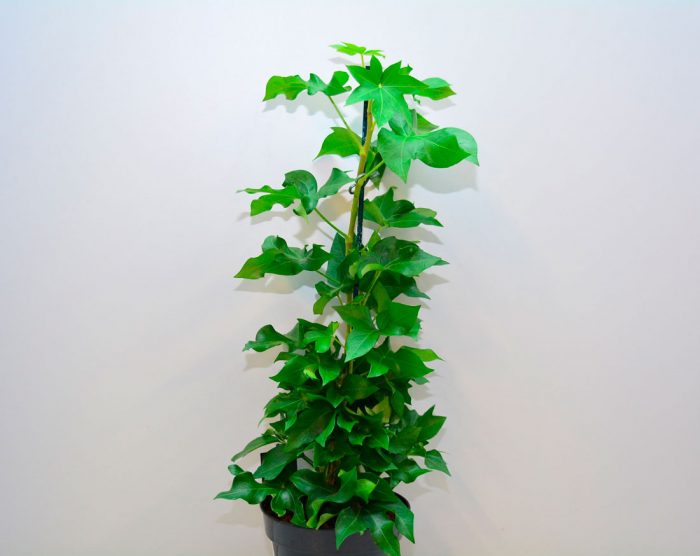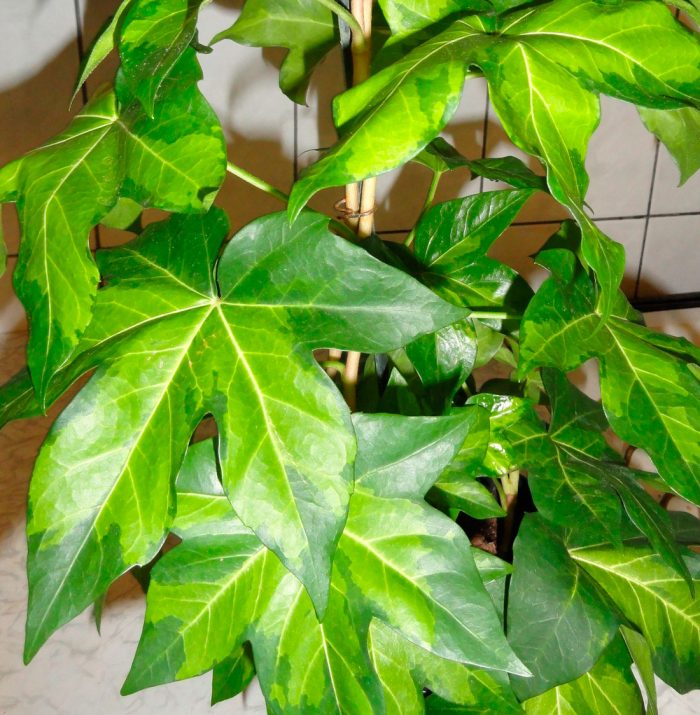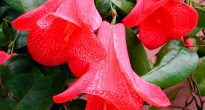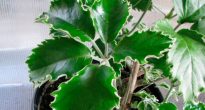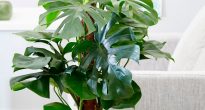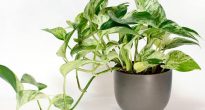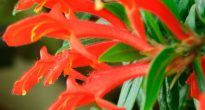The evergreen Fatskhedera vine does not occur in nature, but it was born thanks to breeders in 1912. The Lisi brothers, who were French flower growers, worked on the creation of such an unusual plant. They carried out their breeding work on the territory of the French arboretum of Nantes. Fatshedera was created by crossing Japanese Fatsia and ivy.
Content
Features of fatsheders
Fatskhedera is inherently a rare exotic plant. A very short time after this vine was created, it became very popular among both florists and florists. It is often used to decorate flower arrangements, and is also quite often grown on terraces, balconies and in winter gardens. And such a flower looks great in a spacious hall or foyer.
Fatshedera is distinguished from other plants by large dark green glossy leaf plates that look like ivy and fatsia foliage. During the entire period of foliage growth, its color does not change. The length of the sheet plate is about 30 centimeters, and its width is about 20 centimeters. Their shape can be finger-lobed or trifoliate. Very often, in the subspecies of fatshedera, an irregular border of a white or cream shade passes along the edge of the leaf plate, thanks to which the plant becomes even more spectacular and graceful.
In length, the bush can reach about 5 meters. At first, it looks like a tree, with a semi-lignified weakly branched stem. If there is a desire, then the vine can be constantly grown in the form of a tree, but for this you need to install a support (bamboo or wooden stick). If you pinch the shoots of the tree, then you can form a shrub that will delight you with its gorgeous green foliage for a long time. If there is no support, then the shoot will begin to creep, and over time it will look more like a liana. As it grows, the stem lignifies, and a dark brown bark appears on its surface. During the year, such a plant grows in length by 0.3–0.4 m.
In an adult Fatskhedera, in the last summer or in the first autumn weeks, the formation of globular-shaped umbrellas is observed, which can be painted in a cream or yellowish-green hue.Such flowers are part of paniculate inflorescences. At the end of flowering, dark blue berries are formed on the bush. This plant is very hardy and can be grown outdoors, but only regions where winters are mild and not too cold are suitable for this. When choosing a place for a vine, keep in mind that it needs a lot of bright light.
Seat selection
In order for the Fatskhedera to grow and develop normally at home, she needs to create optimal conditions.
Illumination
This evergreen vine feels best in a place with a lot of bright light. However, it can also be grown in shade. The optimal level of lighting in a room is a little shading. In the spring-summer period, if possible, the fatsheder is recommended to be grown outdoors, for this it can be planted in the garden or transferred in a pot to the balcony. A shady courtyard is perfect for such a plant. However, the choice of location must be taken very seriously, as it must be protected from direct sunlight. The fact is that the scorching sun can burn the leaf plates of a plant.
Humidity and temperature
Fatskhedera is characterized by a fairly high resistance to temperatures observed from spring to autumn. However, if the room is hotter than 25 degrees, the plant will become lethargic and temporarily lose its decorative effect.
In winter, it is recommended to keep the vine in a cool place (from 10 to 15 degrees). At the same time, the air humidity level is kept moderately high. If the room becomes too hot (from 18 degrees and above), then the foliage on the bush must be moistened from a spray bottle, while creating a semblance of a warm shower. By the way, it is recommended to carry out a similar procedure from time to time throughout the year in order to remove accumulated dirt and dust on the sheet plates. This procedure also has an antibacterial effect. Moisten the plant in this way, preferably once a week. In addition, remove dust from foliage weekly with damp wipes. Protect the vine from cold air currents and drafts, as they can greatly harm it.
Fatshedera care at home
You need to take care of the room fatshedera in almost the same way as for other flowers growing at home. It must be watered, cut, fed and transplanted in a timely manner.
How to water
In the spring-autumn period, such an evergreen vine needs abundant watering, which should be carried out quite often. However, make sure that no stagnation of liquid is observed in its root system, otherwise this can cause the development of root diseases. Some time after watering, be sure to drain the excess liquid accumulated there from the pan. In winter, the plant is watered much less frequently and less abundantly.
Depending on the air temperature in the room, the plant is watered with the following frequency:
- at a temperature of 24-26 degrees - 1 time in two to three days;
- at a temperature of 20-24 degrees - the substrate in the pot is moistened 1 time in 5 or 6 days;
- if the temperature in the room is kept at 16-18 degrees, then watering is carried out 1 time in 7-10 days;
- if the room is rather cool (12-15 degrees), then you need to moisten the soil mixture in the pot no more than 1 time in 30 days.
But remember that it is impossible to allow the earthen coma to completely dry out, no matter what the air temperature in the room is. Do not forget to loosen the surface of the soil mixture in the pot 1 time in 15–20 days.
It is possible to understand that there is stagnation of fluid in the root system through the foliage, which will turn yellowish. If the liana needs urgent watering, then this can be guessed by the leaf plates that have lost their turgor, which will go down, and the shape of the crown will also change.
It is recommended to water the fatshedera with well-settled or rainwater, the temperature of which should be close to room temperature. Watering such a liana in the usual way is not recommended; drip irrigation is best for this, which, if desired, can be combined with moistening the bush from a spray bottle.
When planting fatsheads, do not forget to make a good drainage layer at the bottom of the pot. It should occupy a third of the total volume of the container. And from above it is covered with an earth mixture, consisting of 2 parts of sod land, 1 part of sand and 1 part of humus. To create drainage, it is recommended to use small pieces of brick or small expanded clay.
Fertilizer
It is necessary to systematically feed this evergreen liana only during the period of its intensive growth, which is observed from the first days of April to the second half of September. For top dressing, both organic matter and mineral complexes are used, and these fertilizers are recommended to be applied alternately. Fertilize the soil mixture regularly: 2-3 times a month. In winter, when the liana has a dormant period, there is no need to feed it.
You can find fertilizer for such a plant in a specialized store. To do this, you will need fertilizer for a decorative leafy indoor plant, for example: Vympel-2, Master Elite, Alliansed, Agricola, Bona Forte, etc.
Pruning
A similar vine grown indoors is very flexible and resilient. However, if it is not cut off in a timely manner, then one powerful central stem can form in it, while the lateral shoots will develop very poorly. This can cause the vine to lose its attractiveness. After the height of the bush is thirty centimeters, the first pruning is carried out, this is necessary in order to stimulate the growth of lateral shoots. Remember that in some cases, even with optimal growing conditions and good care, side shoots will practically not develop even after pruning, while the bush itself will be depressed and weakened.
In order for your house to be decorated with a spectacular dense liana, it is recommended to plant 2 or 3 seedlings in one container at once, and also do not forget to regularly prune.
Transfer
Until the young bush is five years old, it should be transplanted once a year. Older plants are transplanted less often, or rather, once every 2-3 years, and it is necessary to replace the top layer of soil mixture in the pot every year. However, if you want your vine to always be thick and spectacular, then transplant once a year, regardless of its age.
The transplant pot should be chosen not very wide, but high. Thanks to this, even a thick drainage layer will not interfere with the development of the root system. Do not forget during transplanting that the old flowerpot should be 20-30 mm smaller than the new one.
Experts advise replanting the fatshedera in early spring (approximately in the first days of April), before the bush begins to actively grow. The substrate should be neutral or low acidity. It is recommended to transplant the liana by transshipment, while trying not to destroy the earthen lump.
At the very beginning, you need to prepare a suitable container, and then the substrate. When two or three days remain before transplanting, it is necessary to regularly moisten the soil mixture in the pot, but for this you need to use a small amount of water. Thanks to this preparation, the earthen lump will remain intact during transplantation. Next, remove the bush along with the clod of earth from the old container. In order to make the earthen lump easier to remove from the container, it is placed on a hard and even surface, and lightly knocked along its edges. Instead, you can take a long knife and run it along the inside of the container, trying to separate the soil mixture from the walls of the pot.After that, grabbing the base of the vine, it is carefully pulled out. To harm the plant as little as possible, turn the container on its side.
After the shrub has been removed from the pot, inspect its root system for rot or signs of disease. If you notice signs of rot or some kind of disease, then carefully remove all the substrate, being careful not to injure the roots. After that, cut out all damaged areas with a sharp sterilized tool, and sprinkle the cut areas with charcoal powder. If the roots are healthy, then carefully remove the top layer of the old soil mixture, as well as the drainage layer along with the roots that have grown into it. Then put the bush in a new pot, and in advance make a layer of drainage on its bottom. After the Fatshedera is placed in a new container, all voids in it must be carefully filled with fresh soil mixture. Do not forget that the distance from the top layer of the substrate to the top edge of the container should be from 30 to 50 mm.
Watering the transplanted vine must be correct. Since the substrate was regularly moistened for 2–3 days before transplanting, after transplanting it does not need to be watered immediately. Wait from 1 to 3 days, during this time the plant will dry out and heal the wounds on the roots that could appear during the transplantation process.
Reproduction methods
For reproduction, fatsheders use several methods, namely: seeds, cuttings and air layers.
Cuttings
You can propagate such a plant by cuttings in the warm season. The best time for this is the last weeks of spring or the first weeks of summer. Prepare cuttings about 15 centimeters long by cutting off the apical shoots. For rooting, they are planted in a soil mixture consisting of 1 part of humus, 2 parts of turf and 1 part of sand. Cover the cuttings with a transparent bag on top to help create a greenhouse environment. After new buds are formed on the handle, the bag is removed.
Propagation by air layers
It is relatively easy to propagate a fatshedera with air layers, therefore this method is most popular with flower growers. The beginning of this procedure falls on the first days of April. Pick one leafless side shoot and cut it slightly. Then moistened moss is placed in the area of the incision, and wrapped with foil on top of it. If the sphagnum is wet all the time, then after about a couple of months, roots will form at the cut site. When this happens, part of the shoot with horses must be cut out and planted in a pot of soil mixture. In order for the air layer to quickly take root in a new place, it should be systematically watered. And in order for rooting to be successful, the cutting is covered from above with a glass jar or a transparent bag, the shelter can be removed after a week.
Growing from seeds
Fatshedera can also be grown from seeds, but they must be freshly harvested. For this, the seeds formed on an adult liana are collected and used for sowing. Take a small container, fill it with soil mixture and spread seeds on its surface that do not deepen, but only slightly sprinkle the substrate on top. For seed germination, greenhouse conditions are needed; for this, the crops are covered from above with glass or film. After that, the crops are transferred to a dark place where the air temperature is constantly kept at 27 degrees. If everything is done correctly, then the first seedlings should appear after 4 weeks.
Possible difficulties
When cultivating fatsheads in indoor conditions, the grower may have the following problems:
- The tops of the leaf plates turn yellow, and they themselves become fragile and dry, and also specks appear on them... This is due to the fact that the vine is not watered often enough or very poorly. And foliage can also lose its decorative effect if the bush is in the heat (above 25 degrees).To remedy the situation, you need to water the bush more often, and you will also need to increase the level of humidity in the air. In the event that large brown spots appeared on the surface of the foliage, and the foliage itself began to wrinkle, then this means that the bush was exposed to direct sunlight, which caused burns. The way out of the situation will be to shade the vines from direct sunlight.
- Foliage becomes faded and loses its luster... This happens when the fatshedere lacks light. In this case, the bush is transferred to a place with brighter lighting.
- Liana quickly fades, and a gray fluff forms on its surface... This happens if the room is extremely cold and the humidity is very high. Move the shrub to a location where both temperature and humidity levels are optimal for the plant. Then trim off any wilted leaf blades and loosen the potting soil. After that, the bush is treated with a solution of a fungicidal preparation.
Remember that in an adult creeper, leaf plates can fly around as they grow up, and this is quite normal.
Home value
Since Fatskhedera was created using ivy, she took over not only some genetic characteristics, but also some of the superstitions. For example, it is believed that Fatshedera has an extremely negative effect on men, causing aggression and negative energy in them. There is also an opinion that this vine can survive a man from an apartment, and it is good that if he leaves, he may die. If there is such a plant in the apartment, then the man will try to leave it as soon as possible, or he will not even want to enter it. In addition, both ivy and fatshedera are considered "energy vampires" who consume happiness, self-confidence, optimism and peace of mind.
But the bad qualities of such a plant appear only when it is grown in indoor conditions. If it is planted in a garden, it will, on the contrary, be a reliable protector of the residents of the house. Thanks to him, negative energy will not get into the home.
However, some superstitious people believe that, on the contrary, this vine is very useful, wherever it is grown. It helps to clean the biofield of the apartment, and also has a beneficial effect on the thoughts and character of the residents, and instills in them confidence and peace.
Types of fatsheders with photos
Fatsheders distinguish the following decorative varieties:
Variegata
Dark green leaf blades have yellow or cream edging. This variety is distinguished by its rapid growth, but weak resistance to pests and diseases.
Pia
The whole bush is covered with not very long bright green leaf plates, their edge is variegated, wavy, tightly adjacent to the shoot.
The Silver Prince
This spectacular variety has a silver border on each leaf plate.
Golden variety
Such a plant differs from the others in that in the middle of each leaf plate there is a speck of a golden yellow hue.

